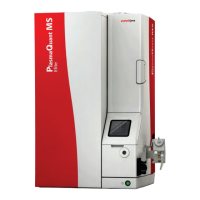PlasmaQuant MS product family Operation
55
5.4 Igniting the plasma
WARNING
Risk of eye and skin injuries due to UV and electromagnetic radiation!
To ensure safe torch operation, you must not ignite the plasma unless the
following
The plasma compartment lid and the interface door are closed and latched.
The water cooler is ready for operation.
Argon supply is ensured.
The exhaust sensor registers sufficient air flow rate.
If this is not the case safety
interlocks will prevent plasma ignition.
Furthermore, the torch and all other components of the sample introduction system
are in working position, are free of deposits and damage.
1. Turn on the water cooler.
2. Tighten the peristaltic pump tubing pressure bars.
3. Open the gas supply valves including iCRC gases.
4. Click the [P
LASMA] button on the main toolbar, or choose PLASMA ON from the
A
CTIONS menu, or press [SHIFT+F4].
If plasma will not light see section "Troubleshooting" p. 127. It is important to ensure
that the torch axis is perfectly aligned on the axis of the sampler cone orifice for
optimal signal efficiency. It is a common practice (but not required) to align the torch
during daily warm-up time scan since it only takes about five minutes to complete (see
section "Torch alignment" p. 59).
5.5 Tuning solution preparations
The following chapters refer to a standard tuning solution whenever using
optimization routines. Freshly prepare a 1 µg/L (1 ppb) solution using the provided
ICP-MS tuning solution, which contains Ba, Be, Ce, Co, In, Pb and Mg (10 mg/L) in 1 %
HNO
3
.
Alternatively, user-defined tuning solutions can be used when tuning the instrument
manually. In general, the concentration of a tuning solution should not exceed 1 µg/L
of each analyte of interest.

